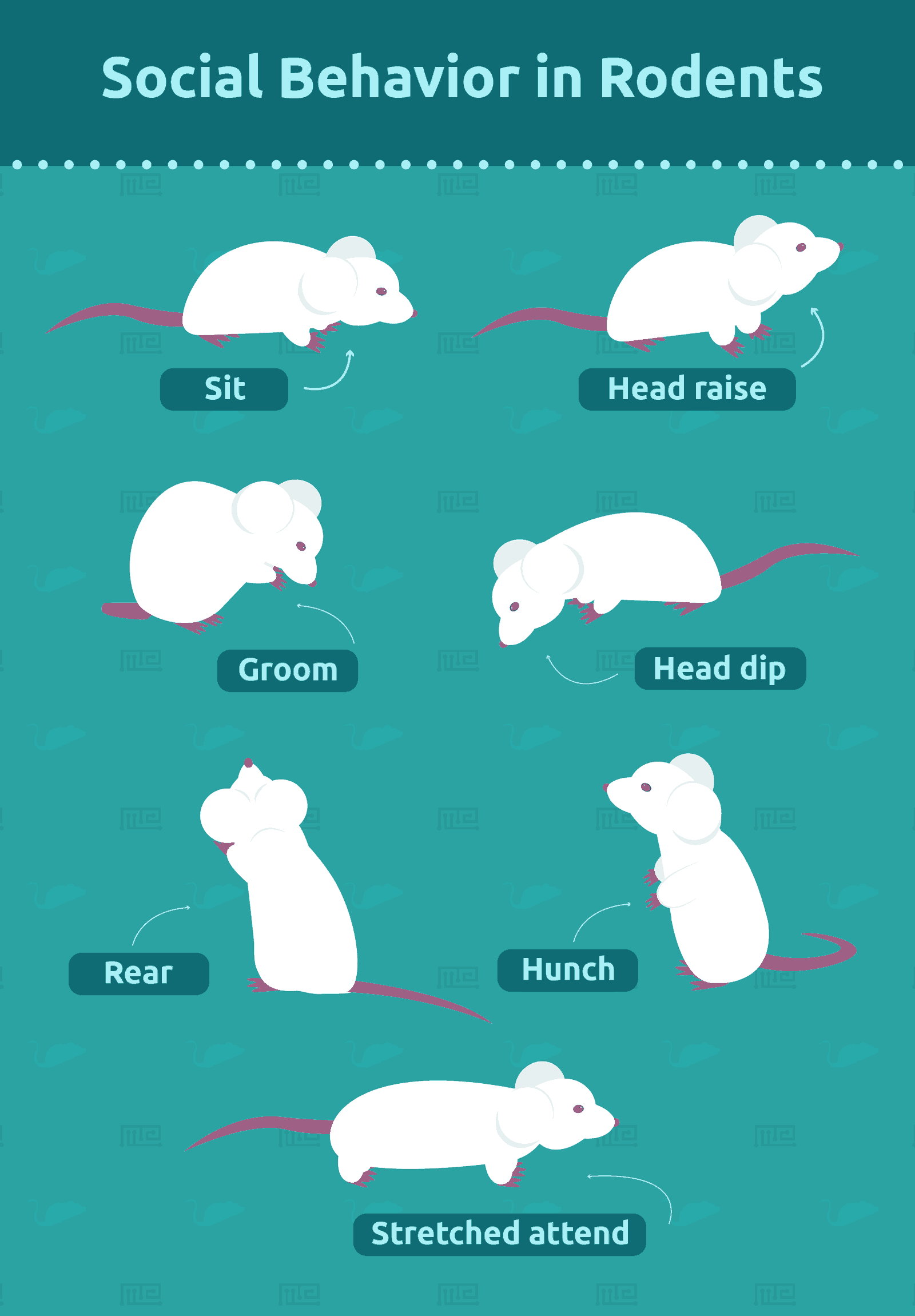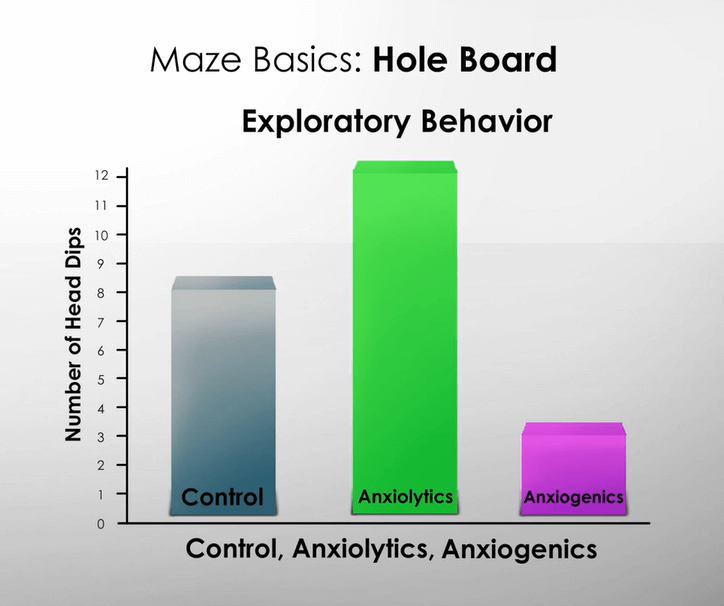Welcome to Maze Basics! Today, we’re going to talk about the hole board apparatus. The hole board test is interesting because it’s so versatile. We’ll talk about some of the different behaviors it can test and how to adapt the board to test each behavior.
The hole board apparatus is a box that has a board near the middle of the box. The board usually has 9 holes evenly spaced out. The hole board apparatus can be used to assess cognitive abilities such as spatial discrimination, memory, and learning. Li et al. (2009) used the hole board apparatus to study the effects of a diet change on spatiala
working memory and reference memory[1].
Working memory refers to when you’re trying to solve a problem, and so you memorize the facts or processes that are important to that specific problem. It’s a bit different from short-term memory because, while it is temporary, you’re able to manipulate and use the memories that you have.
Li et al. (2009) used the standard hole-board apparatus to carry out a hole board test. He filled three of the nine holes with food. In this case, working memory holds the information about which holes the mice have already checked and which holes have food in one trial. If the mouse visits a hole without food, and then within the same trial visits the same hole again, it has committed a working memory error[1].

Reference memory, on the other hand, is a form of long-term memory and helps us create mental representations and associations. Spatial reference memory is important in animals such as rodents due to foraging. Being able to use the environment to retrieve information and routes to find food allows them to survive[2].
During the experiment by Li et al. (2009) for reference memory, the location of the food stayed the same across trials. If the mouse learns where the food is and can go to the correct holes without checking the empty holes, it will have perfect reference memory of this situation. If it visits a hole that doesn’t have any food, it has committed a spatial reference memory error[1].

Typically, a hole visit is defined as when the nose of the animal turns over the edge of the hole or is placed into the hole. Some researchers have even placed an infrared beam at a certain level in the hole and counts a visit as a beam break[2].
When carrying out a hole board test, the apparatus sometimes doesn’t even need to have holes! There have been adaptations to the board to replace the holes with cones or ziggurats and the researchers place the bait on the top instead of inside the hole[2].
Assessing Physical Behaviors
But that’s not where the versatility ends. This apparatus can also test social affinity, risk assessment, exploration, locomotion, physiological arousal, and anxiety. How is it able to do all of this? Researchers have designed a modified board that has the hole board surrounded by boxes/protected areas, with a group compartment on the side[3].
Ohl et al. (2001) carried out a hole board test using the modified hole board. To measure social affinity, they measured the latency to make contact with the group of mice. To measure risk assessment, they counted the number of times the mouse performed a stretched attend posture. This is done when mice are investigating potentially dangerous situations. They measured exploration by counting the number of holes the mouse explores and how often it engages in rearing, or stands up on its hind legs. To measure locomotion, they measured the number of line crossings, i.e. how many times they walk around and break an infrared beam. Physiological arousal was measured based on the amount of time spent on self-grooming and defecation. Finally, they measured anxiety by testing the amount of time the mouse spent on the board, the latency to enter the board for the first time, and the number of times they walked out onto the board[4]. While not all of these were strictly using the hole board apparatus, the apparatus itself allowed for easy modifications to study a wide range of behaviors.

Greater Applications of the Hole Board Test
As with every behavioral test and research study, we want to know how the hole board test can eventually make an impact in our lives. Since the hole board apparatus can test so many different behaviors, it can also test the impacts of drugs or treatments on those behaviors. For example, anxiety and anxiolytic and anxiogenic drugs are widely studied using the hole board test. Anxiolytic drugs are ones that decrease anxiety levels, and anxiety-like behaviors in rodents. Anxiogenic drugs cause increased anxiety-like behaviors.
Takeda et al (1998) studied the effect of benzodiazepine anxiolytics: diazepam and chlordiazepoxide. Both caused dose-dependent increases in exploratory head-dips. As the amount of anxiety-reducing drugs increased, the amount of exploratory behavior increased.
However, when they gave anxiogenics, the reverse results happened: the number of head dips decreased in a dose-dependent manner, and the latency to do the first head dip increased. Overall, exploratory behavior decreased with anxiety-inducing drugs[5].
What You Should Know
The main takeaway is that the hole board test is a multifaceted test. Especially with the modified board, it can test a wide variety of behaviors from anxiety and exploration to learning and memory. The modified hole board can even minimize stress on the animal being tested[6]. If you’re looking for a versatile behavioral test, you might find a lot of luck with the hole board apparatus!
References
- Li W, Dowd S, Scurlock B, Acosta-Martinez V, Lyte M. Memory and learning behavior in mice is temporally associated with diet-induced alterations in gut bacteria. Physiology & Behavior 96(4-5): 557-567 (2009).
- Staay FJ, Gieling ET, Pinzon NE, Nordquist RE, Ohl F. The appetitively motivated ‘cognitive’ holeboard: A family of complex spatial discrimination tasks for assessing learning and memory. Neurosci Biobehav Rev, 36(1):379-403 (2012).
- Labots M, Van Lith HA, Ohl F, Arndt SS. The modified hole board – measuring behavior, cognition and social interaction in mice and rats. J Vis Exp, 98 (2015).
- Ohl F, Holsboer F, Landgraf R. The modified hole board as a differential screen for behavior in rodents. Behav Res Methods Instrum Comput, 33(3):392-7 (2001).
- Takeda H, Tsuji M, Matsumiya T. Changes in head-dipping behavior in the hole-board test reflect the anxiogenic and/or anxiolytic state in mice. European Journal of Pharmacology, 350(1): 21-29 (1998).
- Kim JW, Kirkpatrick B. Social isolation in animal models of relevance to neuropsychiatric disorders. Biological Psychiatry, 40, 918-922 (1996).

